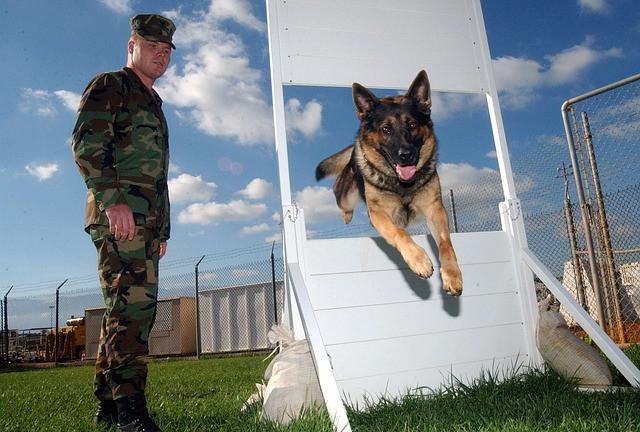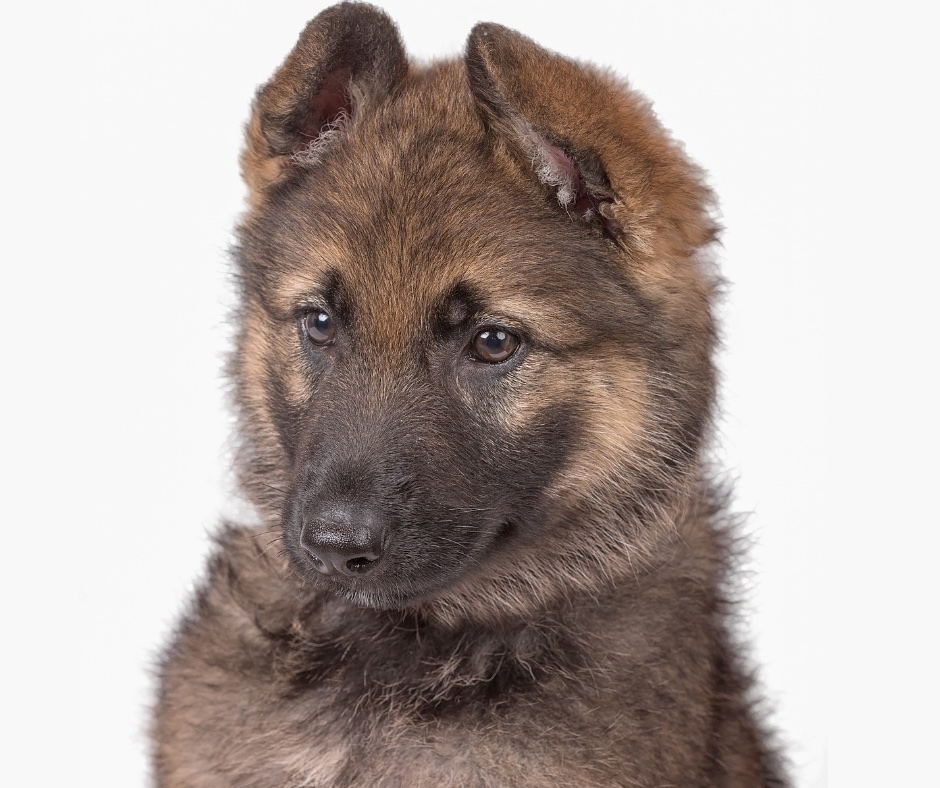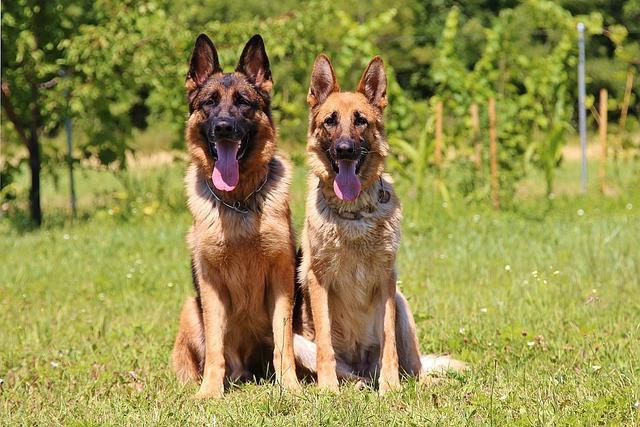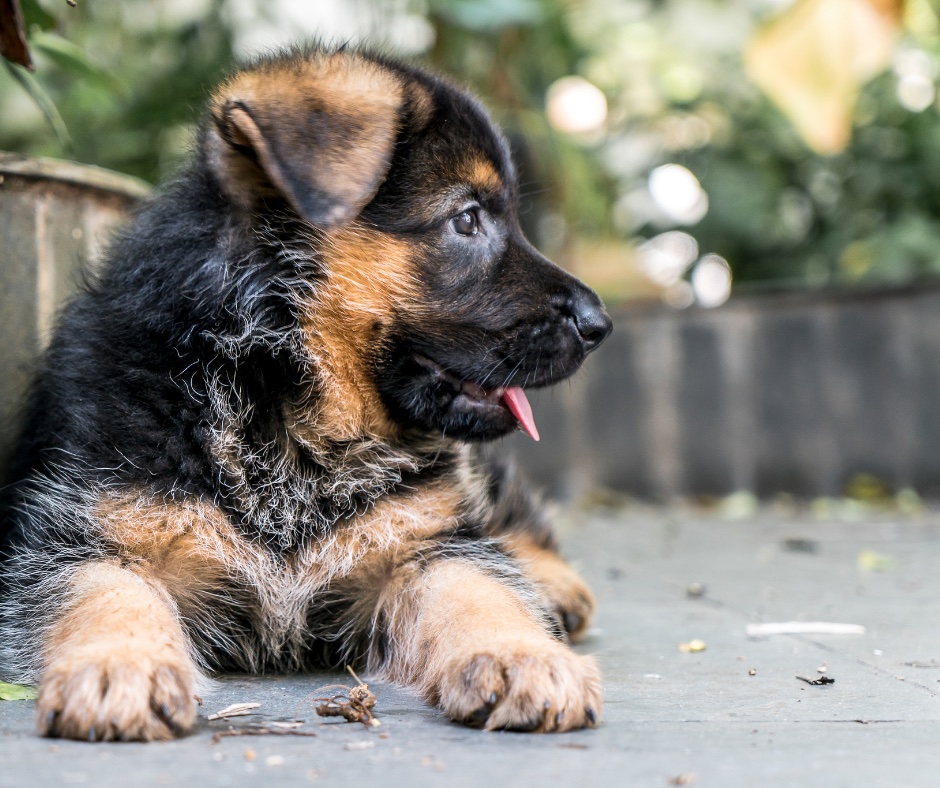Choosing a German Shepherd Puppy is easy but choosing one that is right for you and your family is a lot harder.
Most people see a litter of puppies and suddenly get brain mush from overindulgence in fluffy puppy cuddliness.
What we don’t always think about is that that cute little pup is going to grow into a 40kg intelligent German Shepherd Dog. He will have a personality of his own with social needs that may prove challenging at times.
For the perfect companionship, make sure you buy a healthy German Shepherd puppy with a personality that complements yours.
So how do you choose a German Shepherd Puppy?
Choosing a German Shepherd Puppy [Checklist]
Step 1 – Choose the type of German Shepherd you need.
Step 2 – Choose which colour German Shepherd you like.
Step 3 – Choose which coat length you prefer.
Step 4 – Choose between a male or female.
Step 5 – Understand the importance of personality.
Step 6 – Buy from a reputable source.
Step 7 – Know where not to buy from.
So let’s take a look at them each in more detail below:-
Step 1 – Choose the type of German Shepherd you want
A very important question that will determine which type of German Shepherd Dog will be best for you is what are you wanting to do with it. Do you want to take it to dog shows, do you want it to do a particular job or are you simply looking for a companion?
The reason this is important is that there are actually 2 types of German Shepherd Dog.
Each type is slightly different in appearance and personality.
What are the different types of German Shepherd?
All German Shepherds came from the original German line. This was a working dog breed created to herd sheep, hence its name.
Since its creation, the German Shepherd has been used in so many different job roles other than herding. Over time this has meant breeders of dogs required for these roles have focused on certain traits that make them good at the job they are required to do.
For example, Police dogs and Military dogs need to have extremely high levels of courage, loyalty and obedience. Breeders who enjoy the show ring have bred their dogs to meet the exacting standards of the Kennel Club focusing on their looks, gait and calm nature.
This has led to there being some distinct differences between dogs bred to carry out a job and dogs bred for the show ring.
You will hear of many German Shepherd bloodlines but they will all fall within just 2 different types of German Shepherd dog which are:-
- The Working Line
- The Show Line
The Working Line

The working line is built for stamina and endurance. It has a straight back, a small body, and strong muscles. This line has a lot of energy and is very motivated and fearless. It is also very smart and confident with a strong instinct to protect. These dogs rarely back down when threatened which is why they are very much favoured by the Police and Military.
The coat of a working line German shepherd is often sable, and it is generally short to medium. However, there are working line German shepherds with long coats too. The working line of German shepherds is tougher and usually healthier being less likely to get hip and elbow dysplasia.
Working line German shepherds have a great work ethic. They are very alert and watchful, which means they want to protect their family and see it as part of their job.
There are three main types of German shepherds:
The working line from West Germany, the working line from East Germany (DDR); and the working line from the Czech Republic.
The Show Line

The show line German Shepherd is a much calmer and easier-going pet for a family. They are smart, loving, and loyal dogs that are easy to train. They still have the classic German Shepherd traits in that they are loyal and protective but they are slightly calmer in nature. This can make them less intense and easier to handle.
They are not quite as energetic as the working line but they can still become bored easily and need quite a bit of mental and physical exercise.
There have been a few controversial concerns and health issues raised about the breeding of German Shepherd Dogs over the years. The severe sloping of its back for one led to Kennel Clubs having to intervene and even re-educate show judges on the breed standard.
Thankfully this does not seem to be such a huge problem today. Although if you are considering buying a puppy from the show line I would recommend that you dig a bit deeper into its genetic history. A reputable breeder will be more than happy to provide you with this information.
I have owned both types of German Shepherd Dog and they have both made good pets for me. They all have the same classic German Shepherd characteristics and are gentle family dogs that have been great with kids.
Step 2 – Choose which colour German Shepherd you like.

Your next task is to choose which colour you like best. Just keep in mind that a German Shepherd goes through many colour changes from puppyhood through to about 2 years old when they mature.
My female was mainly black when she was a puppy she now has a lot more tan on her as well. My male was fawn all over and is now a beautiful sable. He gets darker in the winter and lighter in the summer too.
So if colour is important to you speak to your breeder don’t just assume a pup will stay the colour they are when you buy them.
Due to their origins as working dogs, German Shepherds were originally selected for their ability to regulate their body temperature more than for their looks.
Sable was the original operational German shepherd colour but now the American Kennel Club lists 11 standard colours.
The Standard German Shepherd Colours
- Black
- Black & Cream
- Black & Red
- Black & Silver
- Black & Tan
- Blue
- Gray
- Liver
- Sable
- White
- Bi-Color
In the show ring, all colours need to be rich and vibrant with pale and washed out colours being classed as serious faults. Although the British Kennel Club state that colour in itself is of secondary importance having no effect on character or fitness for work.
The most common colour scheme is black and tan although German Shepherds come in a wide range of hues, including black and red and pure black.
Some breeders do breed for colours outside this standard. Whilst they may not make the show ring they are unusual so there is a market for them.
German Shepherds of the Isabella colouration for example are very hard to come by. This is because of the recessive nature of the liver and blue colourings. Puppies with this colouring are quite difficult to breed which makes them desirable and expensive.
If you would like one of these then your search may take quite some time.
Although the Kennel Club has breed standard colours you can choose any colour you like as long as you do not intend to enter your dog in AKC competitions.
Make sure that you don’t simply choose your dog because of his appearance. Back and hip problems are common in German Shepherds, especially amongst the show line. You need to make sure that the puppy’s breeder prioritises health above colour before you acquire him!
The last thing you want is an unhealthy puppy with a gorgeous coat.
Step 3: Choose long hair or short hair.

The length of a German Shepherds coat can vary. Although the original German Shepherd was a short-haired sable nowadays their coats can be much longer.
All German Shepherd dogs are double-coated. This means that they have an undercoat as well as the top coat we can see and feel when we stroke the dog. The undercoat is soft and downy which acts as an insulator against heat and cold and it is this coat that they shed twice a year. Whether you choose a long-haired German Shepherd or a short-haired one you will experience the shedding process. So be prepared to vacuum a lot.
A longer outer coat was originally thought to be a defect in the German Shepherd but it is now recognised by kennel clubs. In fact, the long-haired German Shepherd Dog has proven to be very popular. Not just in the show ring but also in carrying out as many roles as its short-haired counterpart.
They are not as common though so you may have to travel further to find a suitable breeder.
So what length of fur you choose is totally down to personal preference although the longer the coat expect to spend more time grooming.
Step 4: Choose Male or Female

I have had 3 female German Shepherd dogs and 1 male. I also know a few breeders, trainers and a lot of other people with German Shepherd dogs from both sexes. To be honest, as far as German Shepherd traits are concerned I really don’t think there is much between them.
The difference in my dogs has been mainly down to their personality, not their gender. Both male and female dogs can have the same health issues, they both have the same life expectancy, they both reach adulthood at around 2 years old and they both have the same German Shepherd natural traits.
The only differences I would say there are between them are as follows:
The Male German Shepherd Characteristics
- Are often bigger and stronger than the females.
- They reach sexual maturity at around 9 months.
- If not fixed they may be distracted by females in heat.
- They pee a lot to mark their territory.
The Female Male German Shepherd Characteristics
- Are usually smaller and daintier than the males.
- They will have their first heat season around 6 months old.
- If not fixed they will have a heat season twice a year.
- They pee a lot just before and during their season
You will notice that I have not said anything about male German Shepherd dogs being more dominant. The reason for this is that I don’t think they are as a general rule.
Dominance has more to do with the dog’s personality, how confident he or she is and whether they feel the need to have control over or influence a situation.
My female dog is actually much more dominant than my male. Yes, he is much bigger and stronger than her but when you watch them together it is very clear that she calls the shots.
So I wouldn’t focus too much on this unless you really do have a specific preference. The main thing to consider is the dog’s personality or temperament.
Step 5 – Understand the importance of personality
So by now, you should have decided which type of german shepherd you want and the colour and coat length. You should also know if gender is important to you and have details of local breeders in your area.
The final step is making sure you get the right personality match. This is probably the last thing people think of when choosing a German Shepherd puppy but it’s actually the most important. So many German Shepherd Dogs end up in shelters purely because of a wrong personality match with their owners.
Even the most dominant dog will fit in very comfortably if matched with an owner he or she looks up to. Remember that little bundle of fluff you are looking at will grow up to be an intelligent dog with a mind of its own and personality to match.
So how can you choose one puppy from all of those gorgeous bundles of fluff in the litter?
Tips to take away.
1. Know your own personality
Be perfectly honest with yourself are you an introverted person who lacks confidence or are you an extrovert who loves to be out and about.
Your dog needs to compliment not conflict with this so introverts choose a confident puppy extroverts choose one that will look up to you.
2. Ask your breeder.
He or she will know each of those puppies very well. They have watched them grow and develop for the last 8 weeks. They know which one gets to feed first, which one gets pushed about, which one was the first to explore, which was the last etc.
Step 6: Where to go to find breeds
When searching for a purebred German shepherd, there are many things to keep an eye out for and take into account. I would however only recommend that you buy from 2 sources.
A reputable breeder or a reputable rescue centre.
About Breeders
Reputable breeders have to work to the breed standard. Their goal is to produce exceptional quality puppies and eradicate any unwanted health or temperament issues. They know the breed inside out and keep up to date with the latest news on health issues or tests. They are proud of their puppies and most likely attend dog shows to showcase their achievements. They only choose the best dogs for breeding and ensure they are tested for health and temperament issues beforehand.
These puppies will come with papers that prove their pedigree, any tests that were done such as hip scoring and their health records.
They will have been registered with the Kennel Club. This means the breeder has to comply with strict animal welfare and registration criteria.
What does a good German Shepherd breeder look like?

- They only breed German Shepherd Dogs.
- The dog and puppies will know him or her.
- They will be passionate and knowledgeable about the breed.
- They will be happy to answer any questions and show you photographs of your puppy’s lineage grandparents etc.
- They will be registered as a breeder with your country’s Kennel Club and have kennel club registration documents.
- They will ask you to sign a contract.
- They will encourage you to keep in touch as they will love to hear updates on the puppy’s progress.
- They will confirm their willingness to take the puppy back at any age if for any reason you are unable to keep it.
How to find a good breeder
You can find reputable breeders through the Kennel Club in your country but do be aware that anyone can actually register including puppy farms. The Kennel Club will take action to remove them if they become aware that a breeder is not complying with animal welfare but only if they are made aware of it.
For this reason I would recommend that you rely on a recommendation from your veterinarian or a specialist German Shepherd Dog Club. The WUSV have a map on their website were you can find all the official German Shepherd Clubs around the world.
so it’s not a guarantee that you . I prefer to ask your veterinarian, dog clubs, boarding kennels, or groomers. All these organisations may provide you with references to local breeders if they know of any.
They typically have an excellent working relationship with trustworthy breeders. Once you have found a breeder. Check they are registered and go and see them.
Rescues
Rescue centres desperately need support from people to help rehome the German Shepherd dogs they help. Although you are unlikely to get a German Shepherd puppy from a shelter. If they have any puppies it is usually because a female dog has come to the shelter already pregnant. The puppies may or may not be purebred German Shepherd puppies and as is the case with most of the shelter dogs their history will not be known.
Many of the adult dogs that end up in shelters are purebred German Shepherds. For one reason or another, their owners have been unable to keep them. It is not their fault and they should not be seen as a lost cause.
The benefit of choosing a mature German Shepherd Dog from a shelter is that it is much easier to know the dog’s temperament. Many of the dogs just need a loving home with some training and support. If you are able to help one of them then this is a wonderful thing.
Step 7 Know where not to buy from
Newspaper and Internet Ads
Scams
Please be wary of the numerous forms of pet scams that are on the increase due to the surge in internet fraud. These people tend to hide behind classified ads as they are easy to distribute.
Users are sometimes tempted by the promise of an adorable puppy or another animal for sale, only to discover that they’ve been conned.
Learn the warning signs of an online pet scam to prevent getting conned by individuals who are selling pets online. For the most part, pet scams begin when a potential victim does an internet search for “free” or “low-cost” pets to purchase.
In most cases, the vendor will offer to give the pet away for free in exchange for a lower price on the pet’s shipping. For example, people nearly always explain that they’re giving the pet away because their kid has died; they’ve relocated for a new job and can no longer provide the animal enough care, or their new residence does not allow pets.
Puppy Farming
Puppy farming is also something that has been given some press over recent years. This is exactly as it sounds and usually does take place on remote farms where the dogs barking will not be heard.
Dogs are kept in extremely poor conditions simply to produce puppies for sale. The puppies are then sold to unsuspecting owners. There is a lot of money to be made from selling pedigree puppies. You can expect to pay around £2000 to £3000 for one in the UK and the US is around the same too. When a German Shepherd Dog is used in this horrific way she could produce 12 to 16 puppies a year. It is animal abuse and organised crime. These criminals will go to great lengths to hide what they are doing even renting out houses and staging family homes.
These poor female dogs are giving birth more than once a year which not only compromises her health the quality of the puppies suffers too.
Do your due diligence and please don’t fund these organisations.
Backyard Breeders
Backyard breeders are not good places to buy from either. These are people who have simply put two dogs together in the hope to make some money. The breeding dogs will not have been screened for health issues that could be enhanced in their offspring if bred together. They probably won’t know much about the breed standard or be able to offer you any paperwork.
Backyard breeders are not good places to buy from either. These are people who have simply put two dogs together in the hope to make some money. The breeding dogs will not have been screened for health issues that could be enhanced in their offspring if bred together. They probably won’t know much about the breed standard or be able to offer you any paperwork.
So don’t be tempted into buying a backyard breeder’s sick puppy either.
If you buy from anywhere other than a reputable breeder the cost could be way more than you may have saved on the purchase. Don’t risk putting yourself through heartbreak. No one wants to watch a sick puppy suffer!
Wrap Up!
Understanding the breed is an important part of choosing the proper German shepherd for your family.
Decide what you want to do with your German Shepherd Dog and then choose a breed type that fits that role.
You then just need to make some personal preference choices on colour, coat length and whether you want a boy or girl.
Pick a puppy which complements your personality. You will need the breeder’s help for this.
Always, Always, Always buy from a reputable source. I really cannot stress this enough.
By taking the time to learn about your new dog’s lineage as well as its origins, you are going to understand its traits and personality far better. You will also have a good idea of what he or she is going to look like when they get older.
Get it right and you will have a friend for life.
I hope this article has helped you but if you have any questions ask them in the comments I will be happy to help.

